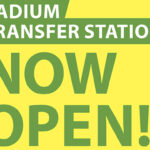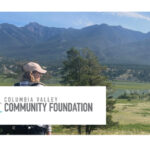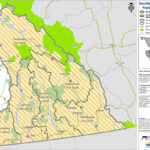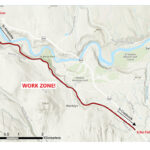Home »

RDEK celebrates 50th anniversary
By Ian Cobb
e-KNOW

The Regional District of East Kootenay (RDEK) turned 50 Nov. 30.
Established in 1965 to provide local government services for rural areas between municipalities, the RDEK has come a long way.
That was made abundantly clear during a special 50th birthday celebration of the RDEK Dec. 3 at Cranbrook’s Heritage Inn. The conference room walls were covered with newspaper clippings from 1965, showcasing the beginnings of the regional government, as well as photographs meant to show “the human side” of the RDEK, explained regional communications director Loree Duczek, who emceed the evening festivities that included speeches by past and current regional directors and staff.

A host of former and most of the current directors were on hand for the celebration, including some from the earlier days of the regional board, such as former board chair Lloyd Sharpe of Electoral Area B, former board chair Ron Tarr of Cranbrook and Electoral Area G’s Eric Rasmussen.
Kootenay East MLA Bill Bennett outlined his close relationship with the regional government, noting the cohesiveness of the board over the years. Bennett singled out the late Jim Ogilvie (long time City of Kimberley Mayor and RDEK board member), noting how much he learned from him and respected his no-nonsense approach to leadership.
Bennett also observed the RDEK is located in the traditional home of the Ktunaxa people.

Ktunaxa Nation Council Chair Kathryn Teneese said Bennett’s acknowledgement was something that didn’t occur when the RDEK was first established and she appreciated it being included now – a sign of how far the region has come.
Board chair, Electoral Area C Director Rob Gay and long-time RDEK employee Lee-Ann Crane, who rose from a position as a front office receptionist to chief administrative officer, both made eloquent speeches reflecting on the rise and evolution of the governance of the southeastern corner of British Columbia.
The following is a transcript of their speeches.
Rob Gay
As we celebrate our 50 years, it gives us a chance to reflect on all we’ve accomplished and look ahead to the years to come. In thinking about what I wanted to include in my presentation tonight, it was difficult to pare it down. There are so many things about the RDEK, our board and our staff that I am proud of – and as I look back on even the past 20 years or so, the diversity of our organization and our ability to change and evolve stands out.

Over the past 50 years, we’ve been governed by a Board of Directors who have brought different experiences and perspectives to the table – and we’ve used those differences to make decisions based on the best interests of the region. Today, we have a board of 16 – 10 municipal and six rural directors – who bring a wealth of knowledge and professional experience to the table. Our differences make us collectively stronger – they give us balance and lead to thoughtful decision -making.
From day one, the regional district has been about providing service. From our roots in planning and the first building and plumbing bylaws passed in 1966, there’s no question we have grown and changed and our services have become more diverse. From specific, low cost, small service areas light street lighting in Moyie to the more regional solid waste, recycling, emergency program and 911 services, today, every resident in the East Kootenay is served in some way by the RDEK.
The evolution of our board meetings – even in the time I’ve served on the board – has been substantial.
In the early 2000s, we still met in the boardroom which is now the Finance and Corporate Services Departments. Agendas were photocopied and it was a week-long task that was engineered by Executive Assistant Merle Fellows. Agendas were delivered by mail through Canada Post to Directors. Enter the Internet era – where advancements in technology and internet capability allowed agenda packages to be put on CDs that were sent in the mail via Canada Post to the board. Before long, computers in the board room and more advanced Internet capacity allowed us to transform into the system we have today: a system that has saved an average of 1,200 pounds of paper a year and allows every member of the Board and the public to access our agendas, staff reports and supporting documentation at the click of a button. It has opened lines of communication and transparency. The agenda packages themselves have also evolved over time. Last month between board, committee and hospital district, we have over 820 pages of information to review.

Communication and public education have always been important to the RDEK – in fact, in 1966 in the Cranbrook Courier, after hiring its first Building Inspector, it was noted that the Board of Directors would begin the task of educating the public about the changes in regulation.
Today, communication is key in everything we do. Our consultative processes involve advisory planning commissions, utility advisory commissions, library boards, emergency services committees, transit commissions, electoral area advisory commissions, planning specific committees and more. On these committees and commissions, we have over 100 volunteers who give their time and expertise to provide us with input and recommendations so that we can make better decisions.
Today, we have Town Hall Meetings, information meetings, open houses, visioning workshops, presentations at community associations, coffee table meetings and more. We have specific email lists that reach thousands of people, an interactive Facebook page and website, email, cellphones and direct lines. These communication tools have all evolved over the past 20 years.
We have had many successful projects because of the partnerships we have formed and nurtured as we’ve collaborated with other levels of government, First Nations, not-for-profit community champions, neighbouring regional districts, Columbia Basin Trust and private sector businesses.

It has been an honour to serve on this board for the past 10 years and to be a part of the many successes of the Regional District of East Kootenay. Over the past 50 years, there have been many challenges – and there have also been many triumphs. We have been recognized for our innovation through services like the Columbia Valley Local Conservation Fund; have received awards for leadership on projects like Carbon Neutral Kootenays and have been recognized federally and provincially as partners for climate protection. We’ve received best practices awards for our website and citizen engagement and we’ve been fortunate to have strong CAOs providing leadership and guidance every step of the way.
Our current CAO Lee-Ann Crane has been recognized provincially for her work on the elections manual and has been honoured by the LGMA for her Professional Service. A great source of pride for me as Board Chair was seeing the results of the client satisfaction survey – in which 90% of respondents reported they received good or excellent service from our staff.
Each one of you here tonight is in some way is part of our story – and our success – over the past half century. With the dramatic changes in the past 50 years, the one constant has been our commitment to providing service to our residents – and we’ve been able to achieve that because of the collective efforts of our board and staff, our partners, and other levels of government.
Thank you for what you bring to the RDEK and for being here tonight as we celebrate this landmark milestone in our history.
Lee-Ann Crane
To set the scene, let’s take a quick look at a bit of what was happening in the world in 1965. The number one song on the Billboard charts was Wooly Bully by Sam The Sham and The Pharoahs. The Sound of Music premiered and won Best Picture and the ever-popular soap Days of Our Lives was launched. The eligibility age for pensions was lowered from 70 to 65 and the B.C. minimum wage was $1 per hour. Gordie Howe scored his 600th NHL goal in Montreal on November 27 and, though it pains me to say it, the Montreal Canadiens beat the Detroit Red Wings four games to two to win the Stanley Cup. The world population was 3,334,874,000. Lester B. Pearson was the Prime Minister of Canada, W.A.C. Bennett was the Premier of British Columbia, and The Queen issued a royal proclamation making the Maple Leaf flag the national flag of Canada.

Amidst all of this, on November 30, 1965 the Regional District of East Kootenay was incorporated. On the first Board there were 15 directors representing Electoral Areas A, B, C, D, E, F and G, and Cranbrook, Kimberley, Marysville, Chapman Camp, Natal, Sparwood, Fernie, and Invermere. The inaugural meeting was held in December, 1965 and the first regular meeting was held on January 22, 1966 in the court room of the Police Administration Building. The directors were paid $25 for each meeting and the chair received an addition $300 per year. For expenses, the directors received $1 for breakfast, $2 for lunch, $3 for dinner; per diem was $25, and use of a personal vehicle was paid at 10¢ per mile or 15¢ if two or more directors travelled in the same car.
About five years ago, I had the privilege of speaking with the RDEK’s first administrator, Mr. Frank Bertoia who served as administrator for about 10 years.
Mr. Bertoia gave me a brochure titled “The Regional District Concept.” The brochure is a transcript of an interview held in 1968 with Minister of Municipal Affairs, Dan Campbell. During this interview he describes the origin of regional districts and some of the challenges and questions that arose upon their creation. One of the questions asked was, “Are regional districts effective as they are now established?” As part of his answer, Minister Campbell stated, “I would say the most successful, effective regional districts are those in the Capital Region (Victoria) and East Kootenay.”
That is something that Mr. Bertoia takes pride in to this very day. And it was upon this very solid foundation that we have been able to build our organization.
What I learned from Mr. Bertoia is that in the beginning, it was not easy for regional districts as they were created with no defined outline of what they should or should not be doing. However, what they did was provide a voice for the rural people – a voice that, over time, has become stronger and stronger. There was much work to be done and many hurdles to overcome. The first task was for the board to appoint a secretary-treasurer. The search resulted in the hiring of Mr. Bertoia who agreed to do the work for $150 per month!
To get started, the RDEK borrowed $10,000 from the City of Cranbrook. This tided them over until the 1966 budget was adopted and some tax money and other revenue started to flow. The first budget was adopted on February 26, 1966 with expenditures totaling $50,425. The requisition was $39,925 and the province provided a grant of $10,000. So they now had some funds and the ability to start doing their real job – the provision of service.
So here was a new local government body with a mandate to be the local government for unincorporated areas and to work cooperatively with their member municipalities in joint services. Now what? Apparently you start with a very vocal administrator, add print and radio advertising, and just ask people what they want for services. You educate and communicate and then you educate and communicate some more. Immediately after each board meeting, the administrator would have a phone conversation with one reporter and go through the board actions resolution by resolution. Taking this time helped to build a good working relationship with the media which, in turn, resulted in a lot of free publicity. Unfortunately, the free publicity wasn’t always what they were looking for. At one point there was a big article in the paper about the purchase of a paper cutter – why would you need one of those, isn’t that a waste of taxpayers’ money?
Was the regional district welcomed with open arms? Hardly. There was much resistance to regulations and the board and staff were cursed up and down on many occasions. It was commonly heard, “I moved out of town to get away from all of these BS rules. Get off my property and out of my life.” It took a while for the rural people to understand the purpose of the regional district and that what was required of them was to ask the regional district to look into whatever services they were interested in, but eventually the concept caught on.
The first services the RDEK took on were building and plumbing inspection and the regulation of sewage disposal. It wasn’t too long until urban renewal, regional parks, land use planning and garbage disposal were also taken on. Grants to libraries followed soon after. According to Mr. Bertoia, the RDEK was the first regional district to give grants to libraries and it was decided to do so because he could see that the province wasn’t going to continue giving money at the levels they had in the past.
An early cause that the RDEK took up was time. The province had dictated that all of B.C. should be on Pacific Time, but the East Kootenay decided it wanted Mountain Time for the extra daylight hours. It was put on the ballot at the next provincial election and the battle was won in favour of the RDEK.

On the land use planning front, one of the first issues that the board was faced with was the Koocanusa Reservoir.
Here is a relatively new organization faced with a situation where residents would be losing their homes, their history. One entire community, Waldo, was lost when the area was flooded. RDEK reps took the time to travel to the U.S. to meet with the US Army Corps of Engineers and some elected officials who were responsible for the project. They just wanted to try their best to ensure that the residents’ interests were looked after.
Another land use planning challenge related to the Columbia Valley. Even at that time they could see that the area was going to develop and, in fact, original plans for Fairmont Hot Springs projected a population of 14,000. It took several years, but zoning restrictions were eventually put in place to try to control development in the Columbia Valley Subregion as best they could.
When it came to dealing with the province, as with any working relationship, there were ups and downs. According to the former administrator, it took a number of years for the province to realize what they had created and what they should be doing. However, it was noted that the Ministry of Municipal Affairs could generally be counted on for support and they, in turn, relied on the new administrators to help figure out just how regional districts could function effectively.
After talking with Mr. Bertoia and researching more of what happened in the years before I started with the RDEK, something became very apparent to me. The more things change, the more they stay the same.
We are still dealing with many of the issues we were 40 years ago. Some rural residents still don’t necessarily appreciate regulations, continuing to make the claim that they moved out of town to get away from regulation. Many of our services are still the same; they may have grown over time, but have the same basic purpose.
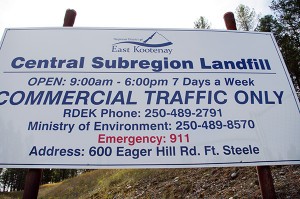 Use solid waste management as an example. In 1970 the RDEK requisition for what was then called garbage and waste disposal was $22,500. In 2015, our requisition for solid waste management was $6.5 million. Same service; just done much bigger and much better with more of a focus on environmental protection and waste reduction. We are participating in a process to ensure local government input into talks associated with the Columbia River Treaty, we still give grants to libraries, we continue to inspect buildings for the safety of our public, and land use planning is still of prime importance for the protection of our valuable land base.
Use solid waste management as an example. In 1970 the RDEK requisition for what was then called garbage and waste disposal was $22,500. In 2015, our requisition for solid waste management was $6.5 million. Same service; just done much bigger and much better with more of a focus on environmental protection and waste reduction. We are participating in a process to ensure local government input into talks associated with the Columbia River Treaty, we still give grants to libraries, we continue to inspect buildings for the safety of our public, and land use planning is still of prime importance for the protection of our valuable land base.
So basically, while the characters may change, our story remains the same. Regional districts were created to provide services and we continue to try our best to provide service as economically and efficiently as we can.
What have been the biggest challenges our rural regional district has faced? First, I would have to say that it is the balancing of very diverse interests. Farming and ranching versus recreational, second home development. Protection of our precious backcountry and water sources, our lakes and rivers, versus the demand for access to these areas and development in and around them. Trying to prevent sprawl and to curtail it in areas where it has already occurred.
Second, is the ability to provide services that are needed and, in most cases, wanted by our permanent and seasonal residents as efficiently and cost effectively as possible while working within the confines of regional district legislation.
What has been our biggest success? I believe we have experienced a series of small successes that have resulted in our organization operating effectively; however, if I had to pick one I would say it has been earning the public’s trust through communication and the great strides we have made in including our permanent and seasonal residents in processes and issues that have a direct impact on their lives and their ability to make a living. Now, more than ever before, people know who we are, what we do, and what we can and can’t do for them.
The moral of this story? The roots of regional districts are based in service provision. We have to be true to our roots and understand that legislation, regulations, and all the other stuff is the means to an end. A key message that I like to deliver is this: it is not about us, it is about them: our public, the people who pay our wages and who trust in us to look after their interests. We have to involve them in all aspects of our operations, communicate with them on a regular basis, educate them on their services, and recognize and respect their varying interests.
And so here we are, December 3, 2015 – 50 years from incorporation. This is a time to look back and celebrate our success. It is also a time to look forward, to think about our individual and organizational potential, and to realize that the last 50 years have only been the start of something great.
Please see more on the RDEK’s 50th birthday HERE.
Lead image: Top row from left: Area F Director and Board Vice-chair Wendy Booth, Tom Shypitka (City of Cranbrook) and Area B Director Stan Doehle. Middle row from left: Mayor Don McCormick (City of Kimberley), Mayor Clara Reinhardt (Village of Radium Hot Springs), Mayor Ute Juras (Village of Canal Flats), Area E Director Jane Walter, Mayor Dean McKerracher (District of Elkford), Mayor Mary Giuliano (City of Fernie), Mayor Cal McDougall (District of Sparwood), Area G Director Gerry Wilkie. Front row: Eric Rasmussen, Lloyd Sharpe, Ron Tarr, Area C Director and Board Chair Rob Gay and Area A Director Mike Sosnowski. Missing: District of Invermere Mayor Gerry Taft (who had to leave to put his wee son to bed and City of Cranbrook Mayor Lee Pratt (who was ill and could not attend). Ian Cobb/e-KNOW

